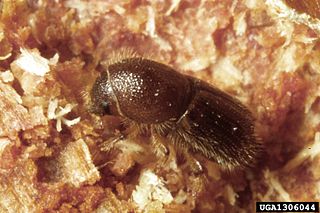
Ips confusus, known generally as the pinyon pine beetle or pinyon ips, is a species of typical bark beetle in the family Curculionidae. It is found in Central America and North America.

Ips avulsus, the small southern pine engraver, is a species of typical bark beetle in the family Curculionidae. The pheromones ipsenol, ipsdienol, and lanieron combined attract the most colonization in the host material in regards to the chemical ecology of the small southern pine engraver, which also effects their reproduction processes.
Ips borealis is a species of typical bark beetle in the family Curculionidae. It is found in North America.

Phloeotribus is a genus of crenulate bark beetles in the family Curculionidae. There are at least 150 described species in Phloeotribus.
Pseudochoragus is a genus of fungus weevils in the beetle family Anthribidae. There are about six described species in Pseudochoragus.
Phloeosinus pini is a species of crenulate bark beetle in the family Curculionidae. It is found in North America.
Ips woodi is a species of typical bark beetle in the family Curculionidae. It is found in North America.
Sphenophorus mormon is a species of beetle in the family Dryophthoridae. It is found in North America.
Scolytus muticus, known generally as the hackberry engraver or hackberry beetle, is a species of typical bark beetle in the family Curculionidae. It is found in North America.
Phloeosinus sequoiae is a species of crenulate bark beetle in the family Curculionidae. It is found in North America.
Corthylus punctatissimus, the pitted ambrosia beetle, is a species of typical bark beetle in the family Curculionidae. It is found in North America.
Phloeosinus scopulorum is a species of crenulate bark beetle in the family Curculionidae. It is found in North America.
Phloeosinus canadensis, the northern cedar bark beetle, is a species of crenulate bark beetle in the family Curculionidae. It is found in North America.
Sphenophorus hoegbergii is a species of beetle in the family Dryophthoridae. It is found in North America.

Ips paraconfusus, the California fivespined ips, is a species of typical bark beetle in the family Curculionidae. It is found in North America.
Ips pilifrons is a species of typical bark beetle in the family Curculionidae. It is found in North America.

Ips pini, known generally as the pine engraver or North American pine engraver, is a species of typical bark beetle in the family Curculionidae. Males construct nuptial chambers in the bark of dead pine or spruce trees. Ips pini is a tremendous pest when it comes to pines, but mostly of mature red pine plantations. When humans try to get rid of them by trying to burn their habitat, it makes them reproduce even more. As trees get wider, their population ends up competing with other species, but mostly because of the temperature and the chemicals used to stop them is helping the beetle even more.
Phloeosinus serratus, the juniper bark beetle, is a species of crenulate bark beetle in the family Curculionidae. It is found in North America.
Xyleborus ferrugineus is a species of typical bark beetle in the family Curculionidae.
Phloeotribus liminaris, the peach bark beetle, is a species of crenulate bark beetle in the family Curculionidae.





